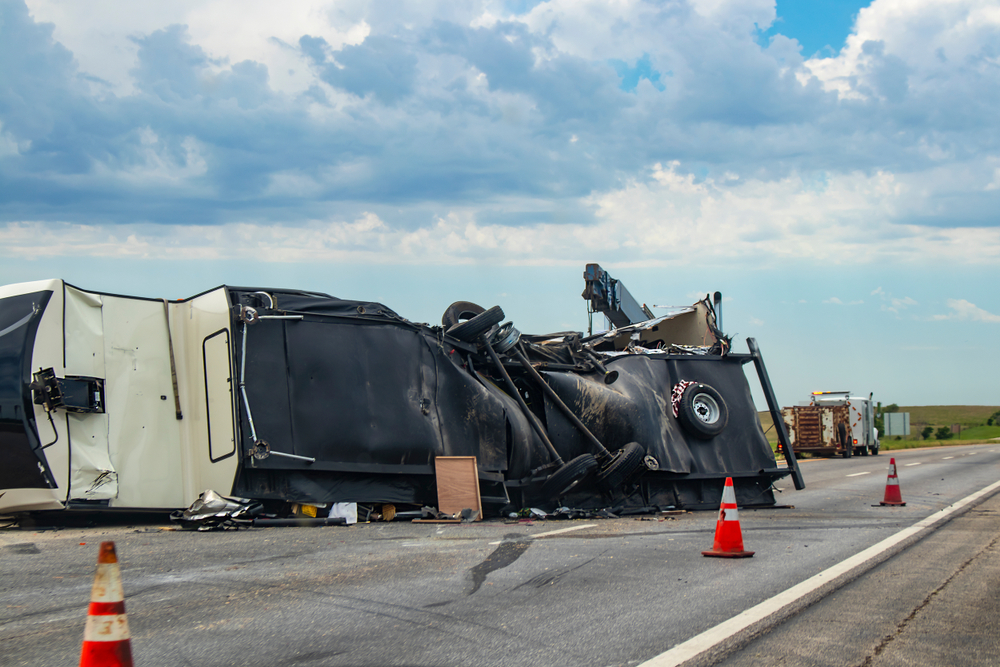Underride truck accidents are among the most dangerous types of road incidents. In these accidents, a smaller vehicle slides under a larger truck, often resulting in life-threatening injuries to those in the underriding car.
The physical recovery from such an accident is often lengthy and incredibly expensive – and the financial recovery can be all but impossible without the help of a Hammond truck accident lawyer.
They can help you file an underride accident claim and seek fair compensation for the harm you suffered.
What Is an Underride Accident?

In underride accidents, the smaller vehicle’s safety features, like airbags and seat belts, often fail to protect the occupants effectively. This is because most car safety mechanisms are there to absorb impacts at the level of the car’s bumper, not at the higher level of a truck’s trailer.
When a car slides under a truck, the impact bypasses these safety features, directly hitting the car’s passenger compartment.
There are two main types of underride accidents: side underride and rear underride. A side underride crash happens when a car slides under the side of a trailer. This can occur if a truck crosses or turns onto a road and a car hits the side of its trailer.
A rear underride crash happens when a car crashes into the back of a truck or trailer. This can occur when a truck suddenly stops, slows down, or starts backing up, and the car’s driver doesn’t have enough time to react.
Why Are Underride Accidents So Dangerous?
Several factors make underride accidents more dangerous than other truck accidents, such as the risk of:
Bypassing Vehicle Safety Features
When a car slides underneath a truck in an underride accident, safety measures like crumple zones, airbags, and seat belts often become ineffective. Engineers design these features to absorb the impact at the car’s level, not at the level of the truck’s body. As a result, the main force of the collision directly hits the passenger area.
Passenger Compartment Intrusion
The intrusion of a truck into a car’s passenger compartment during an underride accident is particularly dangerous. This can occur when the lower height of the car allows the truck to penetrate into the space where the passengers sit.
The structural breach can lead to catastrophic injuries, as it compromises the rigid protective barrier of the car’s frame, which can then crumple onto the passengers within.
Severe Head and Neck Injuries
The nature of underride accidents puts passengers at a higher risk for head and neck injuries. In a typical car crash, the lower part of the vehicle absorbs much of the impact, protecting the passengers’ upper bodies.
In an underride crash, the point of impact shifts to the upper part of the car, often at the level of the windshield or roof. This shift exposes the head and neck to the impact force and potentially life-threatening injuries.
Structural Compromise of the Vehicle
Underride accidents compromise the structural integrity of the car, especially at the upper part where the roof and windshield are.
The force of the truck entering these areas can lead to severe deformation or even shearing off of the car’s upper structure. This loss of structural integrity diminishes the protective space around passengers and increases the likelihood of severe injuries.
High-Speed Impacts

Speed intensifies the physical consequences of the crash and reduces driver reaction time, often leading to unavoidable collisions.
Challenging Rescue Operations
Rescue operations in underride accidents are notably more challenging than in other types of crashes. When a car lodges under a truck, it becomes difficult for emergency responders to access and safely remove the occupants.
This complexity can delay the extraction of injured individuals, affecting their chances of receiving timely medical attention. Unusual vehicle orientations can also require special equipment and techniques for rescue, making the process even more difficult.
How Common Are Underride Truck Accidents?
Underride accidents aren’t just dangerous. They’re also difficult to track. States have different data collection methods for these events, and some lack standardized definitions for underride crashes.
Many don’t collect or report data on underride crashes at all. This inconsistency in reporting makes it hard to grasp the true prevalence of the threat.
The statistics we do have, however, shed light on the severity and consequences of these accidents:
- Over the last 10 years, the Government Accountability Office counted, on average, 219 fatalities each year from underride crashes involving large trucks.
- These fatalities represent less than one percent of all traffic deaths annually.
- However, they account for about 5.5 percent of all fatalities from large truck crashes during this period.
- Nearly half (45 percent) of these fatalities occurred when the initial crash impact was at the rear of the truck’s trailer.
- Around 32 percent of underride accident fatalities involved initial points of impact with the side of the trailer.
- About 21 percent of underride crash fatalities involved the front of the tractor as the initial impact point.
- Federal officials have emphasized that, despite representing a small fraction of total traffic deaths, underride crashes tend to be more severe or lethal than other types of crashes.
- The National Highway Traffic Safety Administration (NHTSA) has proposed stronger safety requirements for the rear guards of trailers. Approximately 95 percent of newly manufactured trailers meet these enhanced safety standards.
How Do Underride Accidents Happen?
Now that we know what underride accidents are and why they can be so deadly, we can now consider the underlying causes of these dangerous collisions.
Here are some common examples of contributing factors in underride accident scenarios:
- Inadequate Lighting on Trucks: Trucks that lack proper lighting or have malfunctioning lights are harder for other drivers to see, especially at night or in poor weather conditions. When the rear or sides of a truck have broken or missing lights, other road users might not see the truck in time to avoid crashing into and slipping under it.
- Faulty or Missing Underride Guards: Underride guards are key safety features that prevent smaller vehicles from sliding underneath trucks in a crash. If these guards are missing, faulty, or not strong enough, they cannot stop cars from going under the truck, significantly increasing the risk that a collision becomes an underride accident.
- Improper Parking or Broken-Down Trucks: When truck drivers park their vehicles improperly, especially without adequate warning signs, they can create unexpected road obstacles for other motorists. Drivers who leave broken-down trucks on roadsides create major underride risks. A trucker who stops their truck in an unexpected area creates an underride hazard, especially if they do so at night or in poor weather conditions.
- Sudden Stops or Turns by Trucks: When a truck driver makes a sudden stop or turn, especially without proper signaling, their maneuvers can catch other road users off guard. This sudden movement can lead to situations where the driver of a smaller vehicle cannot avoid crashing into the truck, potentially resulting in a side or rear underride accident.
- Poor Visibility Conditions: Conditions like heavy rain, fog, or dust can significantly reduce the visibility of large trucks. These conditions make it difficult for other road users to see them, especially if the trucks lack adequate reflective materials or lighting. Truck drivers are responsible for taking adequate precautions in such conditions, which might include pulling over until visibility improves.
Who Could You Hold Liable for an Underride Accident?
Various parties could bear liability in an underride accident case, depending on the specific circumstances of the accident.
Here are some possible examples:
- Truck Drivers: If a truck driver’s negligent actions contribute to an underride accident, you could hold them liable. This includes situations where the driver makes sudden stops, turns without proper signaling, or fails to ensure proper lights or reflective materials are on the truck.
- Trucking Companies: The company that owns the truck or employs the driver could also be liable. Beyond liability for the on-the-job actions of their employees, you could hold truck companies directly liable if the accident relates to broader issues within the company, like inadequate training, poor truck maintenance, or pressure on drivers to ignore safety regulations. Trucking companies are responsible for ensuring their vehicles are safe and their drivers have the training to understand and adhere to safety laws.
- Truck Manufacturers or Maintenance Providers: You could hold a truck manufacturer or maintenance provider liable if an underride accident occurs due to a mechanical failure or a fault in the truck’s design. This could happen if defective underride guards or brake problems contribute to the accident. These parties must ensure that all parts of the truck, including safety features, are in good working condition.
- Cargo Loaders: If improper loading or securement causes cargo to shift and makes a truck handle unpredictably, you could hold the party responsible for loading or securing the cargo liable for a subsequent underride crash. Proper cargo loading can ensure truck stability. You could hold cargo loaders responsible if poor balancing, lack of securement, or overloading contribute to an underride accident.
- Government Entities: In some cases, you could hold government entities responsible for road design and maintenance liability for underride crashes. Poor road design, inadequate signage, or lack of proper lighting can create hazardous conditions that increase the risk of underride accidents.
What to Do After an Underride Accident

First, seek medical attention. Follow your doctor’s treatment plan and keep all follow-up appointments. Make a file of any bills and invoices you receive for your treatment in a file for future use.
Next, inform your insurance provider of the accident as soon as you can. Stick to the facts. Do not speculate, and definitely do not apologize. Stay off social media platforms, as insurance adjusters and trucking companies often monitor these, looking for anything they can use to undercut a claim.
If the trucking company or its insurer contacts you with a settlement offer, say you need to think it over. If you sign away your rights now, you risk losing out on the full compensation they really owe you.
Perhaps most critically, you should contact an underride truck accident lawyer for advice as soon as possible. They can handle much of the work involved in building a strong case for compensation.
How a Lawyer Can Help With an Underride Truck Accident Case
Hiring a lawyer is the best thing you can do to protect your rights and bolster your injury claim after an underride truck accident.
They can help by:
- Investigating the Accident: Lawyers have the skills and resources to thoroughly and independently investigate accidents. They can gather evidence, such as crash reports, witness statements, and truck maintenance records, to build a strong case.
- Determining Liability: Your underride truck accident lawyer can identify all parties potentially liable for the accident, which might include the truck driver, trucking company, vehicle manufacturer, and maintenance providers. This will allow you to seek fair compensation from all possible sources.
- Accurately Calculating the Value of Your Claim: Determining the full value of your claim, including potential future expenses, is key to seeking full compensation. A lawyer can put a reasonable estimate for this value that accounts for your full range of losses and expenses.
- Dealing with Insurance Companies: Lawyers have experience dealing with insurance companies and can negotiate effectively on your behalf. They work diligently to keep insurers from undervaluing your claim or pressuring you into an unfair settlement.
- Representing You in Court: If the truck company or its insurer will not make you a fair offer, your underride accident lawyer can take them to court. They can argue your case effectively, using their legal experience to advocate for your best interests.
